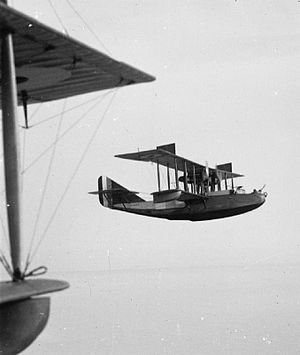Felixstowe F.2
| Felixstowe F.2 | |
|---|---|
 |
|
| Felixstowe F.2A in flight. | |
| Role | Military flying boat |
| Manufacturer |
S.E.Saunders Ltd Aircraft Manufacturing Co Ltd May, Harden & May |
| Designer | John Cyril Porte |
| First flight | July 1916 |
| Introduction | 1917 |
| Primary users |
Royal Naval Air Service Royal Air Force United States Navy |
| Number built | 175 |
| Developed from |
Felixstowe F.1 Curtiss H-12 |
| Variants |
Felixstowe F.3 Felixstowe F.5 Felixstowe F5L |
The Felixstowe F.2 was a 1917 British flying boat class designed and developed by Lieutenant Commander John Cyril Porte RN at the naval air station, Felixstowe during the First World War adapting a larger version of his superior Felixstowe F.1 hull design married with the larger Curtiss H-12 flying boat. The Felixstowe hull had superior water contacting attributes and became a key base technology in most seaplane designs thereafter.
Before the war Porte had worked with American aircraft designer Glenn Curtiss on a flying boat, America in which they intended to cross the Atlantic in order to win the £10,000 prize offered by the British Daily Mail newspaper for the first aircraft to cross the Atlantic. Following the outbreak of war in Europe, Porte returned to England and rejoined the Royal Navy, eventually becoming commander of the naval air station at Felixstowe where he recommended the purchase from Curtiss of an improved version of the America flying boat on which he had worked, the Curtiss H-4 type, resulting in the RNAS receiving two prototype Americas and 62 H-4s.
The Curtiss H-4 was found to have a number of problems, being both underpowered and having a hull too weak for sustained operations and having poor handling characteristics when afloat or taking off. One flying boat pilot, Major Theodore Douglas Hallam, wrote that they were "comic machines, weighing well under two tons; with two comic engines giving, when they functioned, 180 horsepower; and comic control, being nose heavy with engines on and tail heavy in a glide."
...
Wikipedia
